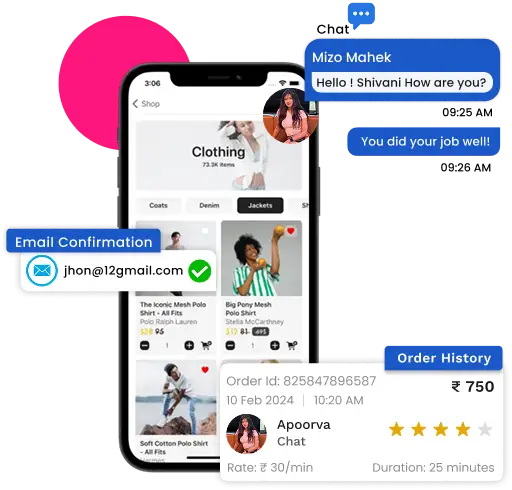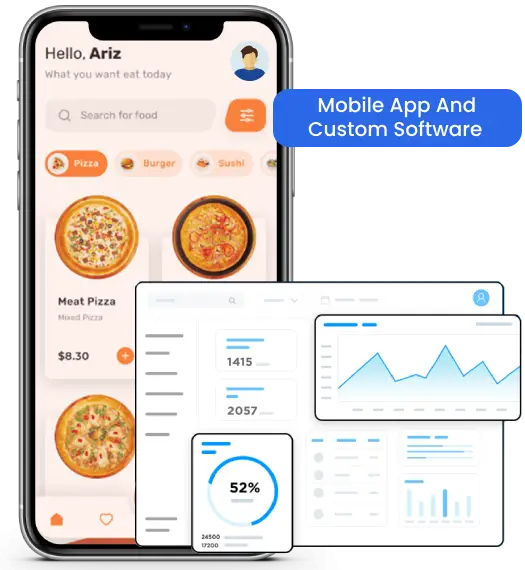When it comes to building a mobile application, there are multiple ways to do it but incomplete knowledge about it often causes hassle. Personalized mobile applications are a great way to build strong relationships with the customers and deliver quality services. According to a report by BusinessofApps, there are more than 5.5 million applications on the Google Play Store and Apple App Store combined. This report reveals the true potential mobile app development industry holds. With the growing popularity of mobile applications, it’s not surprising to see why every business these days is searching for custom mobile app development solutions. However, the common concern faced with the mobile app development is regarding the approach that should be followed to carry out development at a budget. In this blog we will uncover everything along with the mobile app development cost.
“There is a dedicated mobile application for every product and service available in the market.” -Anonymous
What Are the Factors That Impact Mobile App Development Cost?
The cost of developing a mobile app can vary significantly based on several factors:
App Complexity
- Basic App: Simple apps with limited features (e.g., calculators, to-do lists) tend to be less expensive.
- Medium Complexity App: Apps with moderate features (e.g., e-commerce, social networking) require more development time and resources.
- Complex App: Apps with advanced features (e.g., augmented reality, machine learning) have higher development costs.
Platform Selection
- iOS and Android: Developing for both platforms typically doubles the cost compared to a single platform.
- Cross-platform Development: Using frameworks like React Native or Flutter can reduce costs but might compromise performance or features.
Design and User Experience (UX)
- Design Complexity: Elaborate designs and intricate user interfaces increase development time and cost.
- User Testing: Iterative design and testing to enhance user experience add to the overall cost.
Development Team
- In-house vs. Outsourcing: Building an in-house team is costly but provides more control. Outsourcing can be more affordable but might involve communication challenges.
- Developer Location: Costs vary significantly based on the location of the development team.
Features and Functionality
- Core Features: Basic functionalities like user registration, login, and content display are less expensive.
- Advanced Features: Features like in-app purchases, push notifications, and integrations increase costs.
Additional Costs
- Backend Development: If required, developing a backend infrastructure adds to the cost.
- Testing and Quality Assurance: Rigorous testing is essential but increases expenses.
- Deployment and Maintenance: App store fees, updates, and bug fixes contribute to the overall cost.
How Can I Develop a Mobile App on a Budget?
Developing a mobile app on a budget requires careful planning and strategic decisions. Here are some effective strategies:
- Start with a Minimum Viable Product (MVP)
- Focus on core features: Prioritize essential functionalities to launch your app quickly.
- Gather user feedback: Use the MVP to collect user feedback and iterate based on their input.
- Expand features gradually: Add more features in subsequent updates based on user demand.
- Choose the Right Technology Stack:
- Cross-platform development: Consider frameworks like React Native or Flutter to reduce development time and cost.
- Open-source tools: Utilize free or open-source tools and libraries whenever possible.
- Cloud-based infrastructure: Leverage cloud platforms for cost-effective hosting and scalability.
- Outsource Development:
- Offshore development: Consider hiring developers from countries with lower labor costs.
- Freelancers: Hire freelancers for specific development and deployment tasks to reduce costs.
- Freelance platforms: Utilize platforms like Upwork or Freelancer to find affordable talent.
- Design and Development Best Practices:
- Prioritize user experience: Invest in a well-designed user interface and user experience.
- Optimize performance: Ensure your app runs smoothly on different devices.
- Thorough testing: Conduct rigorous testing to identify and fix bugs early on.
If you follow these strategies, you can develop a successful mobile app without breaking the bank. Remember, it’s essential to balance cost with quality to ensure your app meets user expectations.
Challanges Solved by Choosing Mobile App Development
Mobile app development has revolutionized the way businesses interact with customers and operate. By choosing to develop a mobile app, businesses can overcome several challenges:
Enhanced Customer Experience
- Direct Communication: Establish direct communication channels with customers.
- Personalized Interactions: Offer tailored experiences based on user preferences.
- Improved Customer Service: Provide quick and efficient customer support.
Increased Accessibility
- 24/7 Availability: Allow customers to access services anytime, anywhere.
- Expanded Reach: Reach a wider audience beyond physical locations.
- Improved Convenience: Offer on-the-go services and transactions.
Data Collection and Analysis
- Customer Insights: Gather valuable data on user behavior and preferences.
- Market Analysis: Identify trends and opportunities for business growth.
- Personalized Marketing: Deliver targeted promotions and offers.
Competitive Advantage
- Differentiation: Stand out from competitors by offering a mobile app.
- Innovation: Leverage technology to create unique and engaging experiences.
- Increased Market Share: Attract new customers and retain existing ones.
Operational Efficiency
- Streamlined Processes: Automate tasks and improve workflows.
- Cost Reduction: Reduce operational costs through digitalization.
- Improved Decision Making: Utilize data analytics to make informed business decisions.
What is the Cost Involved in Each Step of Mobile App Development?
The cost of developing a mobile app can vary significantly based on several factors, including app complexity, platform, design, and development team location. Here’s a general breakdown of the potential costs:
- Market Research and Planning
- Cost: $500 – $2,000
- Includes: Understanding the target market, competitor analysis, business model development, and feature prioritization.
- UI/UX Design
- Cost: $1,000 – $3,000
- Includes: Creating the app’s visual design, user interface, and user experience to ensure a seamless user journey.
- App Development
- Cost: $5,000 – $15,000
- Includes: Building the app’s core functionalities, such as user registration, login, and content display.
- Testing and Quality Assurance
- Cost: $2,000 – $5,000
- Includes: Rigorous testing to identify and fix bugs, ensuring app performance and reliability.
- Deployment and Launch
- Cost: $500 – $2,000
- Includes: App store submission, marketing, and initial launch activities.
- Ongoing Maintenance and Support
- Cost: Varies based on the level of support required.
- Includes: Bug fixes, updates, server maintenance, and customer support.
- Additional Costs
- Cloud Infrastructure: Hosting the app on a cloud platform.
- Payment Gateway Integration: Setting up payment processing.
- Marketing and Advertising: Promoting the app to acquire users.
- Legal and Licensing: Covering legal and licensing fees.
General Cost Estimates
- Simple App: $5,000 – $20,000
- Medium Complexity App: $20,000 – $50,000
- Complex App: $50,000+
It’s important to note that these are rough estimates. The actual cost can fluctuate significantly based on specific project requirements.
Tech Stack Used in Mobile App Development
- Hybrid Frameworks: React Native, Flutter, Ionic, etc
- Native Programming: Swift, Objective-C, Java, Kotlin
- Backend Technologies: Node.Js, Django, PHP
- Database: SQLite, Realm, MongoDB, MySQL, PostgreSQL
- For Payment: PayPal, Stripe, Razorpay, In-App Purchase, etc
- For User Location or Direction: Google Maps API, Apple Maps API
- For Analytics: Google Analytics
- For Hosting: AWS, Google Cloud, Azure or any other hosting provider
- For Storage: Amazon Cloud Storage, Google Cloud Storage
These are some of the popular technologies used for the creation of a mobile application. Depending on the requirements, developer’s expertise or situation, these might be changed, and a better alternative can be used.
Summary
Developing a mobile application requires careful market research and the identification of opportunities and gaps. Furthermore, you also need to take care of multiple factors that might spike the development cost. If you follow the approach shared above you can save a hefty money while choosing mobile app development solutions.
Now, you have clarity about the factors affecting and cost involved in the mobile app development, it is the perfect time for proceeding with development. At Dreamer Technoland, we follow a strategic approach for building reliable mobile applications by combining prominent tech stack with multiple years of expertise.







